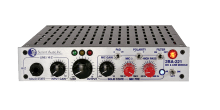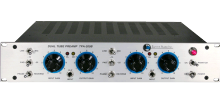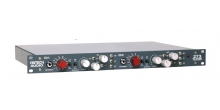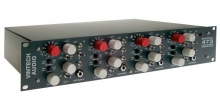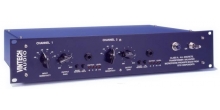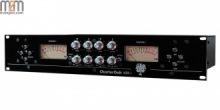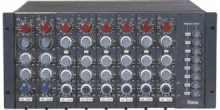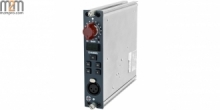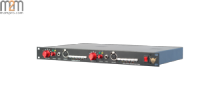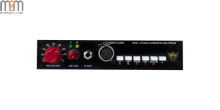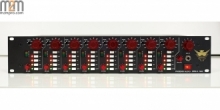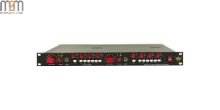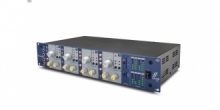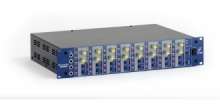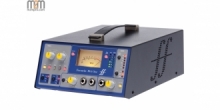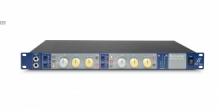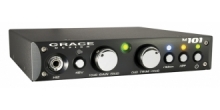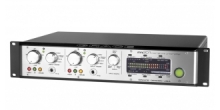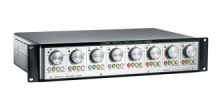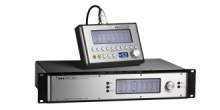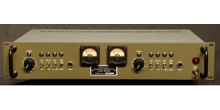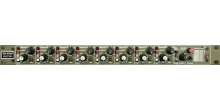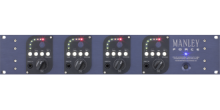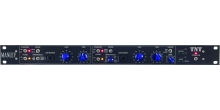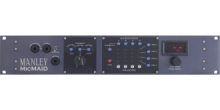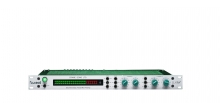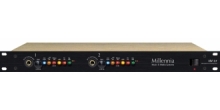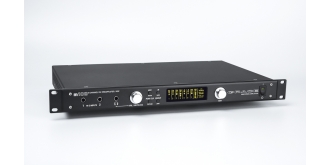 Agrandir l'image
Agrandir l'image
MICROPHONE PREAMPLIFIER – Analog IN to Analog OUT
| Frequency Response | ||
| @ 40dB gain ± 0.2dB (50Ω source) | 15Hz-300kHz | |
| @ 40dB gain ± 3dB (50Ω source) | 4.5Hz-1.0MHz | |
| THD+N | ||
| @ 20dB gain +20dBu out, 1kHz | <.0003% | |
| @ 40dB gain +20dBu out, 1kHz | <.0010% | |
| @ 60dB gain +20dBu out, 1kHz | <.0080% | |
| Intermodulation Distortion | ||
| @ 40dB gain +20dBu out | ||
| SMPTE/DIN 1:1 (50Hz, 7kHz) | <.001% | |
| SMPTE/DIN 4:1 (50Hz, 7kHz) | <.0020% | |
| Noise - Referred to Input | ||
| @ 60dB gain, 50Ω source | -129dB | |
| @ 60dB gain, 150Ω source | -127dB | |
| @ 60dB gain, 600Ω source | -123dB | |
| Phase Deviation | ||
| 40-20KHz @ 40dB gain | < 5° | |
| Crosstalk | ||
| Any Channel @ 40dB gain 1kHz | -127dB | |
| Any Channel @ 40dB gain 10kHz | -113dB | |
| CMRR | ||
| @ 60dB gain, +20dBu CM, 1kHz | >75dB | |
| @ 60dB gain, +20dBu CM, 10kHz | >85dB | |
| @ 60dB gain, +20dBu CM, 60Hz | >55dB | |
| Maximum Output Level | ||
| Balanced, 1kHz, 100kΩ Load | +27dBu | |
| Balanced, 1kHz, 600Ω Load | +23dBu | |
| Unbalanced, 1kHz, 100kΩ Load | +21dBu | |
| Impedance | ||
| Input | Ribbon Mode (+48V OFF) | 19kΩ |
| Input | +48V ON | 8kΩ |
A/D CONVERTER - All measurements at 15dB Gain, Fs=48kHz unless otherwise noted.
| Dynamic range | ||
| 22Hz-24kHz, 14dB Gain, 48kHz | >117dB | |
| “A” weighted, 14dB Gain, 48kHz | >120dB | |
| THD+N | ||
| 1kHz, -1dBFS, 15dB Gain 20Hz-22kHz | < 0.0004% | |
| Intermodulation Distortion | ||
| IMD SMPTE 4:1 60Hz, 7kHz, -3dBFS | < 0.002% | |
| Frequency response | +/-0.2dB | -3dB |
| 44.1kHz Fs | 15Hz-21kHz | 6Hz-22kHz |
| 48kHz Fs | 15Hz-23kHz | 6Hz-24kHz |
| 88.2kHz Fs | 15Hz-41kHz | 6Hz-44kHz |
| 96kHz Fs | 15Hz-45kHz | 6Hz-48kHz |
| 176.4kHz Fs | 15Hz-54kHz | 6Hz-72.5kHz |
| 192kHz Fs | 15Hz-59kHz | 6Hz-79kHz |
| Full scale input level, analog output @ 0dBFS +24dBu | ||
| Crosstalk | ||
| Interchannel crosstalk, 1kHz | < -140dB | |
| Interchannel crosstalk, 10kHz | < -130dB | |
| Group Delay , AES3 Out | < 22/Fs | |
| 44.1kHz Fs | < 0.5ms | |
| 48kHz Fs | < 0.5ms | |
| 88.2kHz Fs | < 0.25ms | |
| 96kHz Fs | < 0.25ms | |
| 176.4kHz Fs | < 0.13ms | |
| 192kHz Fs | < 0.13ms |
DA CONVERTER/Headphone Amplifier - All measurements at Fs=48kHz unless otherwise noted.
| THD+N | |
| 0dBFS In, Volume + 90, +8dBu Out, 22Hz-22kHz BW | < 0.0006% |
| 0dBFS In, 1.0V Out (31mW), 22Hz-22kHz BW, 32Ω load | < 0.0025% |
| Intermodulation Distortion | |
| SMTPE/DIN 4:1 50Hz, 7kHz, 1.0V out, no load | < 0.008% |
| SMTPE/DIN 4:1 50Hz, 7kHz, 1.0V out, 32Ω load | < 0.008% |
| Frequency response | |
| Fs=96kHz , ±3dB | 0.5-45.9kHz |
| Fs=96kHz , ±0.2dB | 0.5-45.9kHz |
| Dynamic Range | |
| 20-22kHz bandwidth | 112dB |
| 20-22kHz bandwidth and A weighting filter | 115dB |
| Output Noise | |
| 20-22kHz, volume=0-90 | -104dBu |
| A weighting filter, volume = 0-90 | -106dBu |
| 20-22kHz, volume=90.5-99.5 | -97dBu |
| A weighting filter, volume = 90.5-99.5 | -100dBu |
| Crosstalk | |
| 1kHz | < 98dB |
| 20kHz | < 72dB |
| Attenuation Range | 0 to -99dB, 0.5dB steps |
| Channel Tracking Accuracy | +/-0.05dB |
| Maximum Output Level | +18dBu |
| Impedance | |
| Headphone Output Impedance | 0.5Ω |
| Control Room Output Module Line Output | 47.5 Ohms |
Clocking and general
| Supported Sample Rates kHz | 44.1, 48, 88.2, 96, 176.4, 192 |
| External Clock Lock Range | |
| FS ± 1.5% | |
| Intrinsic Jitter, 10Hz-20kHz BW | |
| Internal Clock | < 40ps RMS |
| External Clock | < 40ps RMS |
| Jitter Rejection Corner Frequency | 500mHz |
| Weight and Dimensions | 5.2lbs (2.3kg), 1U rack mount W16.75 x D10” |
| Power Consumption | |
| 90-250V~ 50-60Hz | 25 Watts |
GRAC3CF0FB
Nouveau
Grace Design - m108

The finest sounding, most capable mic preamplifier we have ever created.
From 25 years experience of creating acclaimed professional audio products, comes the latest evolution of our mic preamplifier design: the m108. With eight channels of our transparent, musical mic preamplification, state of the art A/D conversion, multiple digital output formats, and flexible local or remote controlled operation, the m108 is a vital addition to any modern audio production environment.
Unrivaled Performance
Based on the acclaimed success of our m802 remote controlled mic preamplifier, the m108 distills the best of these achievements into a sleek, elegant 1U chassis design. Our transformerless, transimpedance mic preamp design is unmatched in its ability to effortlessly resolve complex sonic waveforms, resulting in recordings of amazing clarity and depth. Integrated A/D conversion delivers digital signals to the workstation that are pure and beautiful. Latest generation s-Lock PLL ensures pristine, jitter free sample clock when clocking from external word clock or Dante clock. And an asynchronous mode USB interface provides the best possible jitter performance when connected to a computer.
Simple Operation
A push-button rotary encoder is used for navigating and operation, with a user interface that is simple and intuitive. Dedicated push-buttons are assigned to core functions: 48V phantom power, phase reverse, channel grouping and meter peak clear. A crisp OLED screen displays complete system information, including channel gain settings, metering, peak status, and the system setup menu.
Powerful Configuration
Out of the box, the m108 is ready to go as a stand alone mic preamp / ADC. With integrated serial or MIDI control, the m108 can be configured in large channel-count remote systems, with control from our existing m802 hardware remote control unit, from Protools™, the forthcoming m108 control app, or even simply over Ethernet with any modern web browser. And an optional DANTE™ interface is provided for network audio configurations. The m108 control protocol is backward compatible with the m802 so you can add m108’s to an existing m802 system.
Grace Design Remote Control Software
The m108 Control Software application allows for control of up to 12 m108 preamplifiers using the Ethernet control port on the m108. Each preamplifier in the system will have a dedicated control panel for operating the microphone preamplifiers, ADC, and clocking parameters. The control application allows for the creation of channel groups as well as saving and recalling presets. The application runs under Windows (7,8.1,10) and Mac OS (10.11). For control of the m108 via Android or iOS use the m108 web interface.
m108 Web Browser Control
The m108 has a built-in web browser controller allowing remote control from most web enabled Mac, Windows, iOS and Android devices. This control has been optimized for Chrome, but will operate on most modern web browsers (excluding Internet Explorer). This makes control of any m108 on an ip LAN as simple as entering the m108's IP address into the browser's navigation window, and the web browser control from that preamp will automatically load and connect. See the m108 owner's manual for complete details.
Curious about the differences between the m108 and the m802?
At the core, both mic preamplifiers are quite similar. They both utilize our signature transimpedance (or current feedback) amplifier topology, they have no electrolytic capacitors in their signal paths, and each preamp channel has its own power supply voltage regulators. These are the key ingredients in how we design our mic preamplifiers, which lend very similar sonic performance to both units. However, there are many differences in design execution and features:
The m802 has external, dual redundant power supplies. The power supply unit used in the m108 is the same as the m802 and m905, but the m802 uses two of them for NASA level reliability (more expensive). Redundant or not, this design is currently 100% reliable, without a single failure in the field since the 6 years they have been deployed.
The m802 has two adjustable ADC sensitivity settings which are accessible via setup menus. This requires a fair amount of additional circuitry and components (more expensive). The m108 ADC sensitivity is fixed at +24dBu or +18dBu (at the analog output) for 0dBFS and is changed via internal jumpers (less expensive).
The m802 ribbon mode uses a relay to bypass the input phantom power blocking capacitors (more expensive).In the m108, we use very high quality metalized film capacitors for this which are exceedingly transparent sounding (less expensive).
The m802 has two sets of balanced analog outputs (more expensive) while the m108 has one set (less expensive).
The m802 has separate circuit boards for the preamps, a back plane pcb for interconnect, a controller pcb, and 4 pcbs in the ADC assembly,15 circuit boards in all (very expensive). The m108 has its preamplifiers, ADC, and controller all on one pcb and the digital I/O on another (less expensive). This really makes up the bulk of the cost savings between the two units. As well there are fewer interconnect cables which means less chance of a contact failure.
The m108 has the latest generation clock technology. The clock jitter in the m108 clock is less than 40ps and the PLL has a low frequency corner of around 500mHz (the m802 PLL corner frequency is 10Hz). This gives the m108 an extremely effective barrier to external clock jitter. We are unable to measure any effects of external jitter even at exceedingly high levels which would not be found in a modern well designed digital audio system.
The measured performance of the m108 slightly exceeds that of the m802 in most areas. These include ADC dynamic range, THD+N, external clock jitter rejection.
The rest of the differences are in features, size, weight, and power consumption. The m108 represents the single biggest R&D effort in our company's history. We really focused on increasing performance and maintaining bomb-proof reliability while reducing the cost of the system. We are really proud of this unit and are amazed with its stunning clarity and musicality.
- 8 channels of balanced analog preamp outputs
- 8 channels of transparent, musical mic preamplifier
- Wide gain range: -6 to 69dB
- Ribbon mic mode
- 8 channels of 192kHz ADC outputs via AES, ADAT (4ch SMUX) and USB Class 2
- External Word clock in and out
- Reference DAC and headphone amplifier for low-latency monitoring of channel pairs or USB playback from a computer
- Channel 1 & 2 HI-Z inputs on front panel
- High contrast, wide viewing angle OLED display for all system parameters and setup menu
- Combination RS 485/422 serial / MIDI ports for control from existing m802 RCU or Protools™
- Control App (Win and Mac, coming soon) can control up to 96 channels over Ethernet
- Simple web browser control built in, works with all modern browsers including iOS and Android
- RJ45 Ethernet port for network control
- Expansion slot for optional Audinate / DANTE™ network audio card
- Cooling fan for reliable operation in the harshest environments
- Built in 100-240VAC universal AC power supply
- Made in the USA
Features And Specs
MICROPHONE PREAMPLIFIER – Analog IN to Analog OUT
| Frequency Response | ||
| @ 40dB gain ± 0.2dB (50Ω source) | 15Hz-300kHz | |
| @ 40dB gain ± 3dB (50Ω source) | 4.5Hz-1.0MHz | |
| THD+N | ||
| @ 20dB gain +20dBu out, 1kHz | <.0003% | |
| @ 40dB gain +20dBu out, 1kHz | <.0010% | |
| @ 60dB gain +20dBu out, 1kHz | <.0080% | |
| Intermodulation Distortion | ||
| @ 40dB gain +20dBu out | ||
| SMPTE/DIN 1:1 (50Hz, 7kHz) | <.001% | |
| SMPTE/DIN 4:1 (50Hz, 7kHz) | <.0020% | |
| Noise - Referred to Input | ||
| @ 60dB gain, 50Ω source | -129dB | |
| @ 60dB gain, 150Ω source | -127dB | |
| @ 60dB gain, 600Ω source | -123dB | |
| Phase Deviation | ||
| 40-20KHz @ 40dB gain | < 5° | |
| Crosstalk | ||
| Any Channel @ 40dB gain 1kHz | -127dB | |
| Any Channel @ 40dB gain 10kHz | -113dB | |
| CMRR | ||
| @ 60dB gain, +20dBu CM, 1kHz | >75dB | |
| @ 60dB gain, +20dBu CM, 10kHz | >85dB | |
| @ 60dB gain, +20dBu CM, 60Hz | >55dB | |
| Maximum Output Level | ||
| Balanced, 1kHz, 100kΩ Load | +27dBu | |
| Balanced, 1kHz, 600Ω Load | +23dBu | |
| Unbalanced, 1kHz, 100kΩ Load | +21dBu | |
| Impedance | ||
| Input | Ribbon Mode (+48V OFF) | 19kΩ |
| Input | +48V ON | 8kΩ |
A/D CONVERTER - All measurements at 15dB Gain, Fs=48kHz unless otherwise noted.
| Dynamic range | ||
| 22Hz-24kHz, 14dB Gain, 48kHz | >117dB | |
| “A” weighted, 14dB Gain, 48kHz | >120dB | |
| THD+N | ||
| 1kHz, -1dBFS, 15dB Gain 20Hz-22kHz | < 0.0004% | |
| Intermodulation Distortion | ||
| IMD SMPTE 4:1 60Hz, 7kHz, -3dBFS | < 0.002% | |
| Frequency response | +/-0.2dB | -3dB |
| 44.1kHz Fs | 15Hz-21kHz | 6Hz-22kHz |
| 48kHz Fs | 15Hz-23kHz | 6Hz-24kHz |
| 88.2kHz Fs | 15Hz-41kHz | 6Hz-44kHz |
| 96kHz Fs | 15Hz-45kHz | 6Hz-48kHz |
| 176.4kHz Fs | 15Hz-54kHz | 6Hz-72.5kHz |
| 192kHz Fs | 15Hz-59kHz | 6Hz-79kHz |
| Full scale input level, analog output @ 0dBFS +24dBu | ||
| Crosstalk | ||
| Interchannel crosstalk, 1kHz | < -140dB | |
| Interchannel crosstalk, 10kHz | < -130dB | |
| Group Delay , AES3 Out | < 22/Fs | |
| 44.1kHz Fs | < 0.5ms | |
| 48kHz Fs | < 0.5ms | |
| 88.2kHz Fs | < 0.25ms | |
| 96kHz Fs | < 0.25ms | |
| 176.4kHz Fs | < 0.13ms | |
| 192kHz Fs | < 0.13ms |
DA CONVERTER/Headphone Amplifier - All measurements at Fs=48kHz unless otherwise noted.
| THD+N | |
| 0dBFS In, Volume + 90, +8dBu Out, 22Hz-22kHz BW | < 0.0006% |
| 0dBFS In, 1.0V Out (31mW), 22Hz-22kHz BW, 32Ω load | < 0.0025% |
| Intermodulation Distortion | |
| SMTPE/DIN 4:1 50Hz, 7kHz, 1.0V out, no load | < 0.008% |
| SMTPE/DIN 4:1 50Hz, 7kHz, 1.0V out, 32Ω load | < 0.008% |
| Frequency response | |
| Fs=96kHz , ±3dB | 0.5-45.9kHz |
| Fs=96kHz , ±0.2dB | 0.5-45.9kHz |
| Dynamic Range | |
| 20-22kHz bandwidth | 112dB |
| 20-22kHz bandwidth and A weighting filter | 115dB |
| Output Noise | |
| 20-22kHz, volume=0-90 | -104dBu |
| A weighting filter, volume = 0-90 | -106dBu |
| 20-22kHz, volume=90.5-99.5 | -97dBu |
| A weighting filter, volume = 90.5-99.5 | -100dBu |
| Crosstalk | |
| 1kHz | < 98dB |
| 20kHz | < 72dB |
| Attenuation Range | 0 to -99dB, 0.5dB steps |
| Channel Tracking Accuracy | +/-0.05dB |
| Maximum Output Level | +18dBu |
| Impedance | |
| Headphone Output Impedance | 0.5Ω |
| Control Room Output Module Line Output | 47.5 Ohms |
Clocking and general
| Supported Sample Rates kHz | 44.1, 48, 88.2, 96, 176.4, 192 |
| External Clock Lock Range | |
| FS ± 1.5% | |
| Intrinsic Jitter, 10Hz-20kHz BW | |
| Internal Clock | < 40ps RMS |
| External Clock | < 40ps RMS |
| Jitter Rejection Corner Frequency | 500mHz |
| Weight and Dimensions | 5.2lbs (2.3kg), 1U rack mount W16.75 x D10” |
| Power Consumption | |
| 90-250V~ 50-60Hz | 25 Watts |




